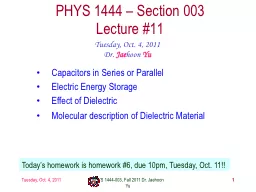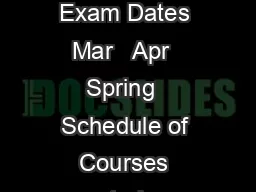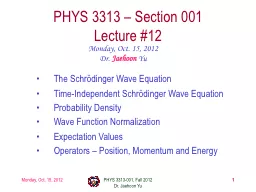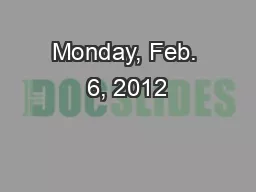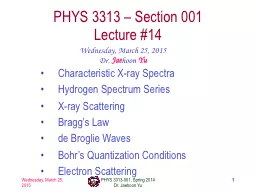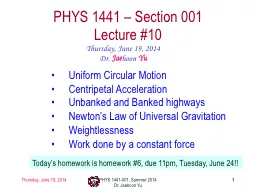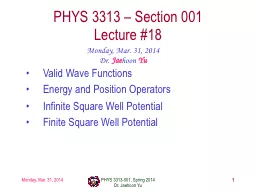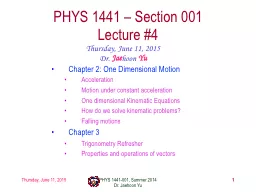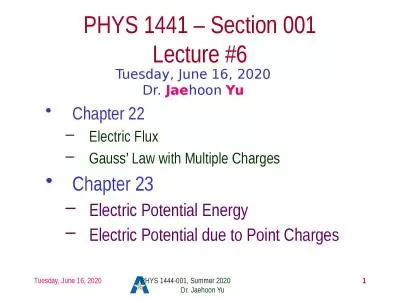PPT-Tuesday, Oct. 4, 2011 PHYS 1444-003, Fall 2011 Dr. Jaehoon Yu
Author : test | Published Date : 2019-06-25
1 PHYS 1444 Section 003 Lecture 11 Tuesday Oct 4 2011 Dr Jae hoon Yu Capacitors in Series or Parallel Electric Energy Storage Effect of Dielectric Molecular
Presentation Embed Code
Download Presentation
Download Presentation The PPT/PDF document "Tuesday, Oct. 4, 2011 PHYS 1444-003, Fal..." is the property of its rightful owner. Permission is granted to download and print the materials on this website for personal, non-commercial use only, and to display it on your personal computer provided you do not modify the materials and that you retain all copyright notices contained in the materials. By downloading content from our website, you accept the terms of this agreement.
Tuesday, Oct. 4, 2011 PHYS 1444-003, Fall 2011 Dr. Jaehoon Yu: Transcript
1 PHYS 1444 Section 003 Lecture 11 Tuesday Oct 4 2011 Dr Jae hoon Yu Capacitors in Series or Parallel Electric Energy Storage Effect of Dielectric Molecular description of Dielectric . DESIGN COURSES 57479573470DWK573475736857366573475735357347573685736757347PXVW57347EH57347FRPSOHWHG57347SULRU57347WR57347HQWHULQJ57347DQ57347XSSHU57347GLY57347057347FRXUVH57361 57479573475736457371573478QLWV57347RI573477HFKQLFDO57347OHFWLYHV57347DUH M TUITION AND FEES PAYMENT DUE 500 PM In person 600 PM Online Non payment of tuition and fees may result in class cancellation Jan 8 Jan 8 Jan 8 Registration Resumes at 700 AM via PAWS Jan 9 Jan 9 Jan 9 REGISTRATION ENDS Jan 10 Jan 10 Jan 10 Early St m STUDENT ACCOUNT PAYMENT DUE 500 pm In person 600 pm Online Jan 7 Jan 7 Jan 7 Course Schedule RevisionsRegistration Permitted via PAWS at 1200 noon Jan 8 9 Jan 8 9 Jan 8 9 Early Student Enrollment Verification Certificate Proof of Enrollment availab PHYS 3313-001, Fall 2013 Dr. Jaehoon Yu. 1. PHYS. 3313 . – Section 001. Lecture . #21. Monday, Nov. 25, 2013. Dr.. . Jaehoon . Yu. Equipartition. Theorem . Classical and Quantum Statistics . PHYS 3313-001, Fall 2012 Dr. Jaehoon Yu. 1. PHYS. 3313 . – Section 001. Lecture . #12. Monday, Oct. 15, . 2012. Dr.. . Jaehoon . Yu. The Schrödinger Wave Equation. Time-Independent Schrödinger Wave Equation. PHYS 3446, Fall 2016. 1. PHYS 3446 – Lecture #11. Wednesday. , . Oct. 12, . 2016. Dr. . Jae. . Yu. Energy . Deposition in Media. Charged Particle Detection. Ionization . Process. Photon Energy Loss. PHYS 1444-004, Spring 2012 Dr. Jaehoon Yu. 1. PHYS 1444 – Section . 004. Lecture . #6. Monday. ,. Feb. 6, 2012. Dr.. . Alden . Stradling. Chapter 23 Electric Potential. Electric Potential Energy. PHYS 3446, Fall 2016. 1. PHYS 3446 – Lecture . #11. Wednes. day. , . Oct. . 12. , . 2016. Dr. . Jae. . Yu. Energy . Deposition in Media. Charged Particle Detection. Ionization . Process. Photon Energy Loss. PHYS 1444-003, Spring 2012 Dr. Jaehoon Yu. 1. PHYS 1444 – Section . 004. Lecture . #3. Wednesday. ,. Jan. 25, 2012. Dr. . Jae. hoon . Yu. Chapter 21. The Electric . Field. Electric Field . Lines. Electric Fields and Conductors. PHYS 3313-001, Spring 2014 Dr. Jaehoon Yu. 1. PHYS. 3313 . – Section 001. Lecture . #14. Wednesday. ,. March 25, 2015. Dr. . Jae. hoon . Yu. Characteristic . X-ray . Spectra. Yu. 1. PHYS . 1441 . – Section 001. Lecture . #10. Thur. sday. , June . 19, . 2014. Dr. . Jae. hoon . Yu. Uniform . Circular Motion. Centripetal Acceleration. Unbanked . and Banked highways. Newton’s Law of Universal . Lecture . #. 18. Monday. ,. Mar. . 31. , . 2014. Dr. . Jae. hoon . Yu. Valid Wave Functions. Energy and Position Operators. Infinite Square Well Potential. Finite Square Well Potential. Monday, Mar. 31, 2014. Yu. 1. PHYS . 1441 . – Section 001. Lecture . #4. Thursday. , June . 11, 2015. Dr. . Jae. hoon . Yu. Chapter . 2: . One . Dimensional Motion. Acceleration. Motion under constant . acceleration. One . 1. PHYS 1441 – Section 001. Lecture #6. Tuesday, June 16, 2020. Dr. . Jae. hoon . Yu. Chapter 22. Electric Flux. Gauss’ Law with Multiple Charges. Chapter 23. Electric Potential Energy. Electric Potential due to Point Charges.
Download Document
Here is the link to download the presentation.
"Tuesday, Oct. 4, 2011 PHYS 1444-003, Fall 2011 Dr. Jaehoon Yu"The content belongs to its owner. You may download and print it for personal use, without modification, and keep all copyright notices. By downloading, you agree to these terms.
Related Documents

